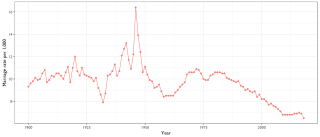Gender
Where the "Solo Generation" Came From
Longer life expectancy, a shifting gender ratio, and more.
Posted April 13, 2023 Reviewed by Vanessa Lancaster
Key points
- Family formation, fertility, and partnership patterns have changed drastically since the mid-1900s.
- This shift is linked to social and cultural changes like the rise of cohabitation and same-sex partnerships.
- The SDT is arguably a global phenomenon that will continue to shape demographic patterns worldwide.

Changes in the demographic makeup of populations are a significant factor contributing to the rise of singledom. In the wake of what researchers call the second demographic transition, fewer people are choosing to get married, or are choosing to get married later, and those who get married are more likely to get divorced.1,2 While these changes in themselves lead to an increase in the proportion of singles in the adult population, they have an additional effect on the relationship patterns of people growing up in this reality.
What Is the Second Demographic Transition?
The second demographic transition (SDT) is a theory that describes the changes in family formation, fertility, and partnership patterns that have occurred in many developed countries since the mid-20th century. The SDT is characterized by a shift away from traditional family structures and toward individualism, postmaterialism, and gender equality.
The SDT is a continuation of the first demographic transition, which occurred in Europe and North America during the 19th and early 20th centuries. The first demographic transition was marked by a decline in mortality rates and an increase in life expectancy, which led to a population boom. The SDT, however, is focused on changes in fertility rates, family formation, and partnership patterns, rather than mortality rates.
According to the SDT, the traditional family structure, characterized by early marriage, high fertility rates, and gender-specific roles, is being replaced by a more individualistic and egalitarian model. A later marriage, low fertility rates, and a greater emphasis on personal fulfillment and self-expression characterize this model. The SDT is associated with a range of social and cultural changes, including the rise of cohabitation, single parenthood, and same-sex partnerships.
The SDT has been observed in many developed countries, including the United States, Canada, Western Europe, and Australia. However, the pace and extent of these changes vary from country to country. Some scholars argue that the SDT is a global phenomenon that will continue to shape demographic patterns around the world, while others suggest that it is limited to specific regions and cultures.
Studies on the Second Demographic Transition
Indeed, cross-national studies have directly linked the age at first marriage and proclivity for marriage: smaller and single-parent families are associated with lower rates of marriages, later age at first marriages, and higher breakup rates.3-9 Moreover, given that conjugal families are becoming increasingly common,10,11 the number of people growing up in large family environments associated with higher rates of marriage is decreasing, which, in turn, results in more adults being single for longer periods of time.12-14
Another demographic change affecting relationship patterns around the world is the increasing life expectancy. As the number of years we are living increases,15 so does the potential amount of time that an individual can live alone, whether this is due to the increased expected widowhood16 or as a result of the fact that never-married or divorced individuals live for longer, resulting (as before) in more adults being single for longer periods of time.14,17
Indeed, many of the people living alone today are elderly.18,19 In developing countries where life expectancy is increasing most rapidly, the number of elderly is expected to inflate the number of singles most drastically. The physical, economic, and social challenges of living alone in old age often place a social and financial burden on the younger generation,20,21 which may also influence an individual’s decision to remain single.
Another demographic feature that has a marked effect on the number of single individuals is the gender ratio. A significantly imbalanced gender ratio reduces the number of local potential partners and, as such, will leave many people single. Today, a gender imbalance occurs mainly for one of three reasons. In some contexts, a strong preference for male children leads to unbalanced gender ratios in China, Korea, parts of India, and other communities across the world.22-25 For example, the gender ratio in some parts of India is as low as 618 women per 1,000 men.26 Given that the majority of society is heterosexual, this leaves approximately one-third of the male population without a potential partner.
Second, and more common in the West, internal migration may cause there to be more available women than men. For instance, a Williams Institute Report indicates that college-educated women and homosexual men are more abundant in U.S. cities than other demographics. In Manhattan, for example, there are approximately 32 percent more single college-educated women than college-educated men. Moreover, between 9 and 12 percent of the men in Manhattan self-identify as gay.27 Naturally, this leaves the pool of potential partners for women narrowed.
Internal migration also brings about challenges for religious communities in which it is acceptable for men to move for a spouse but not so for women.28 These issues have been recorded in many national contexts and cover a variety of communities including Jewish, Mormon, Muslim, Hindu, and Sikh minorities in the West.29,30
Finally, and topically given the increased level of immigration following unrest and conflict in the Middle East during the 2010s, international migration also may cause gender imbalances where the migrating population is itself imbalanced.31 Although the gender imbalance varies with waves of immigration, refugee status, and historical context, it is more common for men to migrate for work or seek asylum alone than it is for women and children.
For instance, Eurostat reports that in 2014, 55 percent of the total applicants for asylum in Europe were made by men.32 While this may seem relatively balanced, a closer look at the age groups reveals a much steeper gender imbalance for younger groups: among 14- to 34-year-olds, 80 percent of applicants were male. This statistic drops only to 66 percent for 35- to 64-year-olds, showing how at ages where migrants may seek partners—especially from within their own communities—their choice may be limited. Gender imbalance, therefore, plays an important role in relationship trends in a wide variety of situations and social contexts.
The sum of these demographic forces is changing today's society. As the trends are only expected to increase, we should start to accept and embrace the solo generation.
Facebook/LinkedIn image: Suteren/Shutterstock
References
1. Van de Kaa, D.J., Second demographic transition. Encyclopedia of population, 2003. 2: p. 872–875.
2. Van de Kaa, D.J., The second demographic transition revisited: theories and expectations. NIDI/CBGS PUBLICATION, 1994(30): p. 81–126.
3. Fu, X. and T.B. Heaton, A cross-national analysis of family and household structure. International Journal of Sociology of the Family, 1995: p. 1–32.
4. Morrison, P.A., Demographic factors reshaping ties to family and place. 1990: Rand.
5. Hogan, D.P., The effects of demographic factors, family background, and early job achievement on age at marriage. Demography, 1978. 15(2): p. 161–175.
6. Michael, R.T. and N.B. Tuma, Entry into marriage and parenthood by young men and women: The influence of family background. Demography, 1985. 22(4): p. 515–544.
7. Ogden, P.E. and F. Schnoebelen, The rise of the small household: demographic change and household structure in Paris. Population, space and place, 2005. 11(4): p. 251-268.
8. Kobrin, F.E., The fall in household size and the rise of the primary individual in the United States. Demography, 1976. 13(1): p. 127-138.
9. Ogden, P.E. and R. Hall, The second demographic transition, new household forms and the urban population of France during the 1990s. Transactions of the Institute of British Geographers, 2004. 29(1): p. 88-105.
10. Cherlin, A.J., Goode's" World Revolution and Family Patterns": A Reconsideration at Fifty Years. Population and Development Review, 2012: p. 577-607.
11. Cherlin, A.J., The marriage-go-round: The state of marriage and the family in America today. 2010: Vintage.
12. Klinenberg, E., Going solo: The extraordinary rise and surprising appeal of living alone. 2012: Penguin.
13. Stone, J., A. Berrington, and J. Falkingham, The changing determinants of UK young adults' living arrangements. Demographic Research, 2011. 25: p. 629-666.
14. Vitali, A., Regional differences in young Spaniards’ living arrangement decisions: A multilevel approach. Advances in life course research, 2010. 15(2): p. 97-108.
15. Oeppen, J. and J.W. Vaupel, Broken limits to life expectancy. Science, 2002. 296(5570): p. 1029-1031.
16. Eng, I., The rise of manufacturing towns: externally driven industrialization and urban development in the Pearl River Delta of China. International Journal of Urban and Regional Research, 1997. 21(4): p. 554-568.
17. Cheung, A.K.-L. and W.-J.J. Yeung, Temporal-spatial patterns of one-person households in China, 1982-2005. Demographic Research, 2015. S15(44): p. 1209-1238.
18. Bengtson, V.L. and N.M. Putney, Who will care for tomorrow’s elderly? Consequences of population aging East and West. Aging in East and West: Families, states, and the elderly, 2000: p. 263-185.
19. Golini, A. and A. Silverstrini, Family change, fathers, and children in Western Europe: a demographic and psychosocial perspective. The Family on the Threshold of the 21st Century: Trends and Implications, 2013: p. 201.
20. Bolin, K., B. Lindgren, and P. Lundborg, Informal and formal care among single-living elderly in Europe. Health Economics, 2008. 17(3): p. 393-409.
21. Portacolone, E., The notion of precariousness among older adults living alone in the U.S. Journal of Aging Studies, 2013. 27(2): p. 166-174.
22. Gupta, M.D., Selective discrimination against female children in rural Punjab, India. Population and development review, 1987: p. 77-100.
23. Park, C.B. and N.-H. Cho, Consequences of son preference in a low-fertility society: imbalance of the sex ratio at birth in Korea. Population and Development Review, 1995: p. 59-84.
24. Budgeon, S., Couple culture and the production of singleness. Sexualities, 2008. 11(3): p. 301-325.
25. Arnold, F. and L. Zhaoxiang, Sex preference, fertility, and family planning in China. Population and Development Review, 1986: p. 221-246.
26. Census of India, Houselisting and Housing Census Data. 2011, Government of India, Ministry of Home Affairs.
27. Choi, S.K. and I.H. Meyer, LGBT Aging: A Review of Research Findings, Needs, and Policy Implications. 2016, The Williams Institute: Los Angeles.
28. Schmool, M. and S. Miller, Women in the Jewish community: Survey report. 1994: Women in the Community.
29. Guttentag, M. and P.F. Secord, Too many women? The sex ratio question. 1983.
30. Birger, J., Date-onomics: How Dating Became a Lopsided Numbers Game. 2015: Workman Publishing.
31. Pedraza, S., Women and migration: The social consequences of gender. Annual review of sociology, 1991: p. 303-325.
32. Eurostat, Eurostat Regional Yearbook. 2015, European Commission: Brussels, EU.




